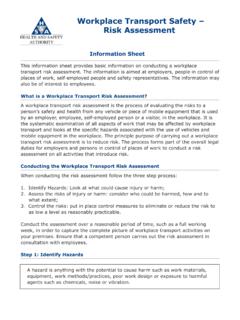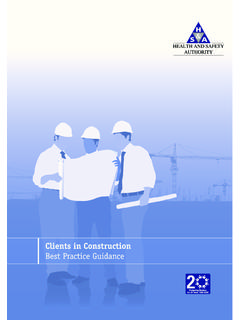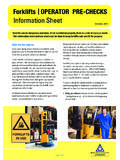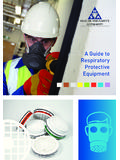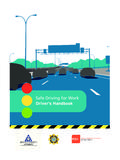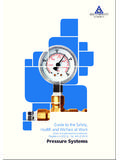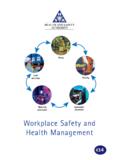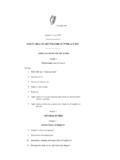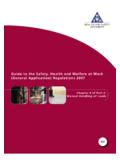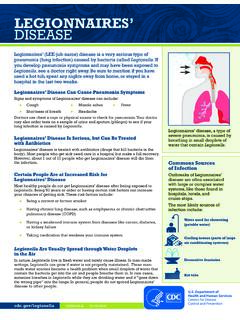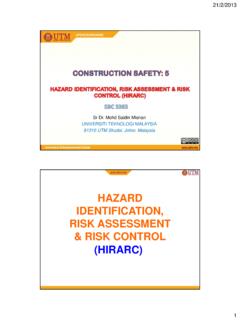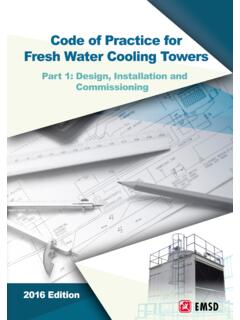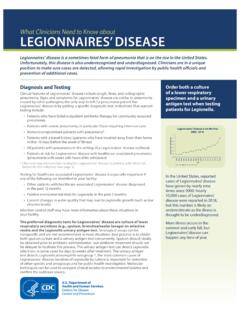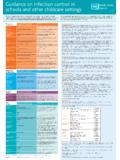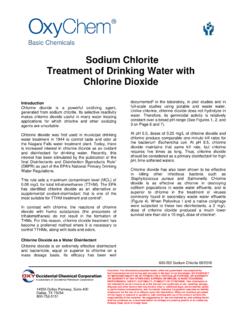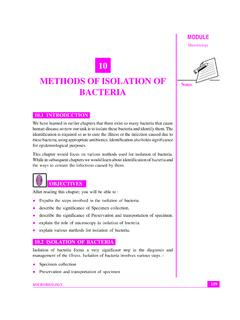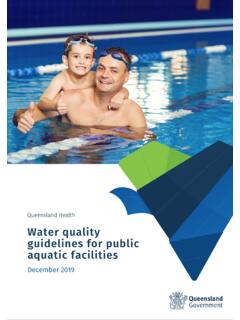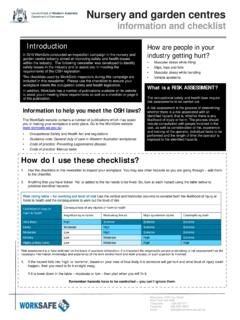Transcription of In association with - Health and Safety Authority
1 Chemical and Biological Safety Guidance for Employers and EmployeesSafety in Contract CleaningIn association withOur vision: A country where worker Safety , Health and welfare and the safemanagement of chemicalsare central to successfulenterprise All rights reserved. No part of this publication may be reproduced, stored in a retrieval system or transmitted in any form or by an means electronic, mechanical,photocopying, recording or otherwise, without the prior permission of the Health and Safety guidance documentprovides information in relation to chemical and biological Safety with respect to those workingin Contract CleaningCleaners are employed in many different types of workplaces, including schools, offices, factories, hospitals, healthcare facilities and retail outlets.
2 Cleaners employed by private contractors are likely to work in a variety ofworkplaces, while in-house cleaners usually work in the same environment. Cleaning staff are often employed in workplaces that have been planned with other workers in mind. Therefore it isimportant that a risk assessment is completed to identify any hazards which the cleaner may come in contact with inthe workplace, and steps should be taken to minimise or reduce the risks from those may be exposed to many different types of hazards in the workplace such as; Chemicals Biological hazards Manual handling Lone Working Confined Spaces Slips, trips and falls Machinery hazards Fire and ElectricityThis guidance document will focus on the chemical and biological hazards that cleaners may encounter andrecommended control measures to control those hazards, for both employers and in Contract CleaningChemical and Biological Safety Guidance for Employers and Employees1 What are the chemical hazards in Contract Cleaning?
3 Many different products are used in cleaning companies. The cleaning products chosen depend on the product to be cleaned. Most cleaning products are made up of the following: Acids and bases such as hydrochloric acid, sulfamic acid, formic acid, sodium hydroxide, and ammonium hydroxide are found in cleaning products for bathrooms and in products to remove lime, concrete, and cement. They can cause irritation and severe burns of the skin, eyes and respiratory system if their fumes are inhaled. Organic solvents and detergents such as white spirits, turpentine, acetone, aromatic hydrocarbons, and alcohol may be found in degreasing products used on floors and other surfaces.
4 These can cause irritation of the skin, respiratory system (through inhalation of vapours), and a toxic effect on the nervous system, brain, kidneys, and liver. Disinfectants such as formaldehyde, glyoxal, and quaternary ammonium compounds can cause allergic reactions and burns to the skin and mucous membranes. Fragrances and colouring agents found in many types of product can cause allergic protective measures should be taken when working with chemicals?Risk AssessmentsA risk assessment should be completed for each place ofwork prior to the worker commencing cleaning activities there.
5 This should take account of any hazards which theworker may be exposed to in the course of their duties working, machinery, manual handling, fire Safety ,chemical and biological Safety . The workplace should alsomake available their own risk assessment to the cleaningstaff to ensure that they are made aware of any otherhazards and precautions which should be taken whilstworking at that place of work. 2 Safety in Contract CleaningChemical and Biological Safety Guidance for Employers and EmployeesSafety Data Sheets (SDS) Safety Data Sheets should be available for all hazardous chemicals used by cleaning staff.
6 The chemical supplier ormanufacturer is responsible for providing this. The Safety Data Sheet should be in English and should be easilyaccessible to the worker. Information in the SDS should be used to make workers aware what hazards are present inthe chemicals being handled and how to protect themselves whilst handling it Safety gloves may be required ifthe chemical is an irritant or corrosive. For more information on SDS s refer to the Safety Data Sheets for HazardousChemicals Information Sheet which can be downloaded for free from the publications section on Note: Employers should substitute hazardous substances with less hazardous substances, where practicableLabels on Chemical ContainersThe hazard classification information provided on the label of the chemicalprovides some information on the hazards and precautions to take when usingthe product.
7 More detailed information is provided in the Safety Data Sheet (SDS).All substances must be labelled according to the Classification Labelling andPackaging (CLP) Regulations hazard pictogram, hazard classification, hazardphrase, precautionary statements. Training should be provided to cleaningworkers on understanding the danger symbols, now called hazard pictograms onthe label and SDS and the Safety advice for each chemical handled. Storage of ChemicalsIt is useful to keep an inventory or list of all chemicals used in theworkplace. This helps to keep track of what is in stock, and mayalso be used to identify out of date or un-used chemicals.
8 Any un-used chemicals should be disposed of safely. Chemicalsshould be stored in a safe and secure location. Cleaning workersoften have a central storage depot where all products are storedand where they collect their cleaning chemicals and equipmentneeded. Chemicals should be stored in a tidy manner andseparated according to their hazard classification chemicalslabelled as flammables should be stored separately fromchemicals labelled as oxidisers. Safety in Contract CleaningChemical and Biological Safety Guidance for Employers and Employees3 Diluting ChemicalsDiluting chemicals can create risks if too little or too much of the chemical is manufacturer s instructions should be followed closely.
9 The use of pre-measuredchemicals or measuring devices which remove the need for the worker to measure amountsat each time of use can be useful to reduce the risk of waste and of ChemicalsSome chemicals should never be mixed. This information is contained in the Safety Data Sheet. For example bleachcontains sodium hypochlorite, a chemical which can cause skin and respiratory damage. This should not come incontact with ammonia or with toilet cleaners or drain cleaners as a harmful gas can be created which can causesevere Health and AwarenessThe level of training that workers receive varies from company to company.
10 Some companies develop their ownprocedures and train staff internally using their own training programmes. The Quality and Qualifications Ireland(QQI) which incorporates the Further Education and Training Awards Council (FETAC) awards also has some courseswhich are relevant to cleaning. Refer to Accredited training courses are also available from the BritishInstitute of Cleaning Science (BICSc). Refer to are the biological hazards in Contract Cleaning?Sources of biological hazards may occur through contact with bacteria , viruses, insects, animals, andhumans.
